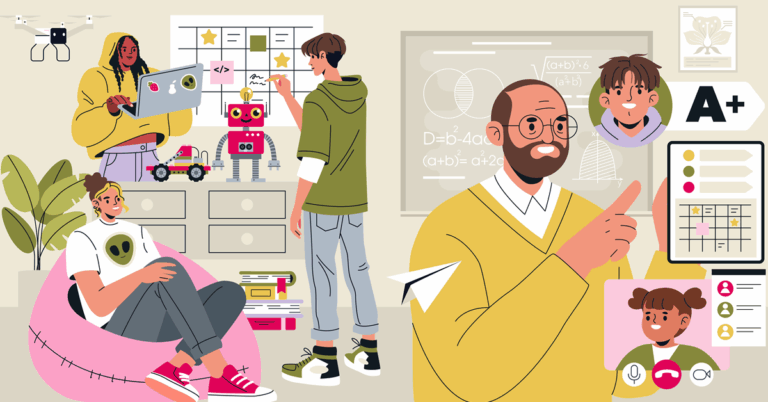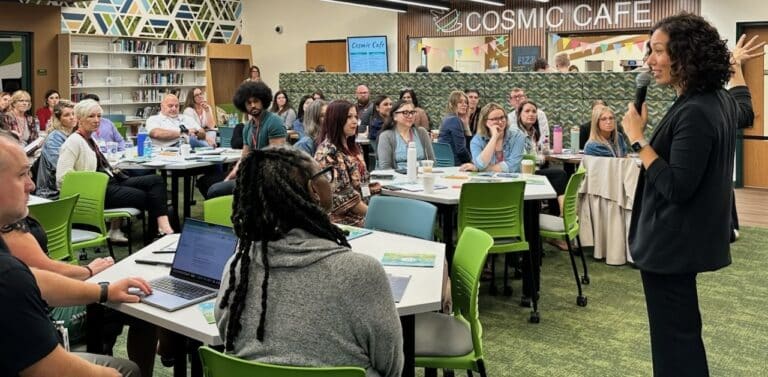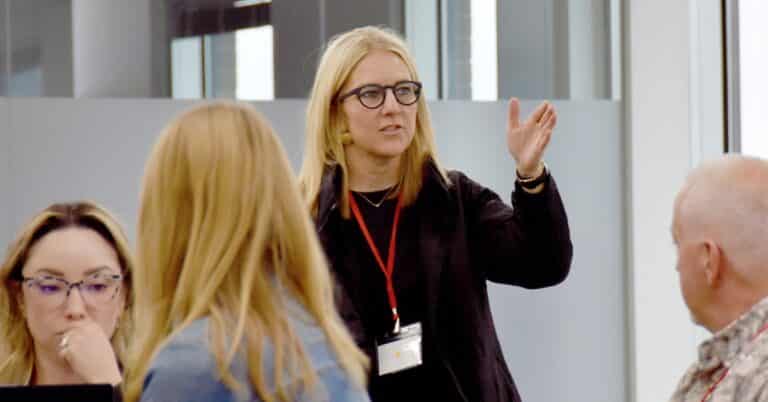Common terms and phrases used when talking about personalized, learner-centered environments
A – E | F – J | K – O | Q – T | U- Z
- Agency
- The initiative and capacity to act in a way that produces meaningful change in oneself or the environment. (Closely related terms: ownership, student-ownership)
Sources: “Anytime, Anywhere.” Wolfe, Steinberg and Hoffman, eds. (2013). Chpt. 7. | “Motivation, Engagement, and Student Voice.” Toshalis and Nakkula. (2012) - Anytime/Anywhere Learning
- Students have equitable opportunities to learn outside of the typical school day and year, and outside of the classroom or school, often by using digital technologies that allow them to study and complete assignments at any location and at any time. Some systems and states award credit based on these experiences. (Closely related terms: blended learning, project-based learning, real-world learning, extended learning opportunities)
Source: “The Students at the Center Framework.” JFF (2013). - Assessment-Capable Learners
- Learners who understand their current level of understanding, the learning path, can select tools and resources to guide their learning, seek feedback and monitor their own progress to adjust the course as needed.
Source: Frey, N., Fisher, D., & Hattie, J. “Developing ‘Assessment Capable’ Learners.” Educational Leadership. Alexandria, VA.: ASCD, 75 (5), 46-51, 2018 - Blended Learning
- Any formal education program in which a student learns in part through online learning and in part in a supervised, brick-and-mortar location away from home. High-quality blended learning combines the best of face-to-face instruction with the best of learning online and some elements of student control over time, place, path and/or pace.
Source: “Maximizing Competency Education and Blended Learning.” Patrick and Sturgis (2015). p. 17 - Collaborative Group Work
- Students work together with peers around academic work, which supports their healthy academic and social development in ways that a teacher-directed model of working alone cannot. Effective group work is well planned and strategic. Students are grouped intentionally, with each held accountable for contributing to the group work. Activities are designed so that students with diverse skill levels are supported as well as challenged by their peers. Teachers design collaborative group work around meaningful tasks in the subject area which are conceptually rich, engaging, with multiple entry points.
Sources: “Collaborative Culture: Group Work” | “Common Instructional Framework.” - Collective Advocacy
- A group’s shared belief in its conjoint capability to organize and execute the courses of action required to produce given levels of attainment.
Source: Donohoo, J., Hattie, J., & Eells, R. “The Power of Collective Efficacy.” Educational Leadership. Alexandria, VA.: ASCD, 75 (5), 46-51, 2018” - Competency
- A competency is what a learner needs to know or know how to do: a relevant academic or social-emotional concept that is aligned to standards and spans multiple contexts and disciplines.
Source: “The Past and the Promise: Today’s Competency Education Movement.” Le, Wolfe, Steinberg (2014). - Competency-Based Education
- An educational system in which each student gets what they need to reach their fullest potential and master high standards through flexible pathways, differentiated support, individual and collective tasks and multiple means and opportunities to demonstrate skill development. Students have individual agency as well as collaborate in co-constructing pathways and measures of learning. Standards, competencies and measures of mastery incorporate community input and voice to ensure pathways reflect universal design for learning non-biased. (Closely related terms: proficiency-based learning/education, mastery-based learning/education.)
- Continuous Improvement
- The act of integrating quality improvement into the daily work of individuals in the system. The concept rests on the belief that improvement requires an organizational or professional commitment to an ongoing process of learning, self-reflection, adaptation and growth. ‘Continuous’ connotes three organizational characteristics: a. the frequency of quality improvement work; b. the depth and extent of its integration at different levels of the organization; and c. the extent of contextualization within a system of work processes.
Source: “Continuous Improvement in Education.” Park, Hironaka, Carver and Nordstrum. (2013). - Culturally Responsive Teaching (CRT)
- Practices and dispositions that seek to perpetuate and foster linguistic, literate and cultural pluralism as part of the democratic project of schooling. Culturally responsive teaching (CRT) is about improving instruction and helping students of color and others – who’ve historically been marginalized due to structural inequities in our education system – become better learners. CRT follows a multi-pronged methodology comprised of cultural awareness, information processing and learning partnerships. CRT should not be confused with multicultural or culturally relevant education, in which multiple cultures are celebrated; but core barriers to learning for historically marginalized learners are neither examined nor improved.
Source: “Zaretta Hammond on Coaching and Culturally Responsive Teaching.” Rebora (2019). - Deeper Learning
- A set of competencies students must possess to succeed in 21st-century jobs and civic life, including:
– Master core academic content
– Think critically and solve complex problems
– Work collaboratively
– Communicate effectively
– Learn how to learn
– Develop academic mindsets
Source: “Deeper Learning Defined.” Hewlett Foundation (2013). - Design Thinking
- An orientation to learning that focuses on identifying need, challenging assumptions, generating a range of possibilities and learning through targeted stages of iterative prototyping. This is a key component of the process not just to solve but to define problems. This seemingly subtle shift can energize one towards empathetic action.
Source: “What is Design Thinking?” Stanford University REDLab - Equity
- Educational equity means that each child receives what he or she needs to develop to his or her unlimited academic and social potential. Working toward equity in schools involves:
– Ensuring equally high outcomes for all participants in our educational system; removing the predictability of success or failures that currently correlates with any social, economic or cultural factor
– Interrupting inequitable practices, examining biases and creating inclusive, multicultural school environments for children and adults
– Discovering and cultivating the unique gifts, talents and interests that every member of the learning community possesses
Source: National Equity Project. Educational Equity: A Definition. - Exit Tickets
- Short formative assessment exercise given at the end of a class or unit that helps the teacher obtain formative data about students’ current levels of understanding. Exit tickets generally ask students to: Rate their current understanding of new learning; Analyze and reflect on their efforts around the learning; Provide feedback to teachers on an instructional strategy; Provide feedback about the materials and teaching. (Closely related terms: exit slips)
Source: “The Many Uses of Exit Slips.” Marzano (2012).
- Formative Assessment
- Ongoing, non-punitive classroom assessments that are administered in the course of a unit of instruction in order to identify students’ strengths and weaknesses; foster increased autonomy and responsibility for learning on the part of the student; assist educators in planning subsequent instruction; and aid students in guiding their own learning, revising their work and gaining self-evaluation skills.
Source: “Handbook of Formative Assessment.” Andrade and Cizek, eds. (2010). - Growth Mindset
- The belief that intelligence can be developed and one’s abilities grown through hard work and persistence, rather than innate talent. Students with a growth mindset understand that they can grow smarter through hard work, the use of effective strategies and accessing help from others when needed. It is contrasted with a fixed mindset: the belief that intelligence is a fixed trait that is set in stone at birth.
Source: “What We Know About Growth Mindset from Scientific Research.” Romero (2015). - Individual Learning Plan
- A student-directed planning and monitoring tool that customizes learning opportunities throughout students’ secondary school experience, broadens their perspectives and supports attainment of goals. The plan documents students’ interests, needs, supports, course selections (including access to college level programming), transition placements and other learning experiences both in and out of school.
Source: “What is an ILP?” Rhode Island Department of Education (2019). - Instructional Framework
- An instructional framework includes agreed upon common language and beliefs for teaching and learning for instruction in order to discuss effective teaching, give and receive feedback, and collect data to monitor growth.
Source: Adapted from “Creating an Aligned System,” Marzano, Schooling, and Toth
- Learner-Centered
- Integrating personalized approaches, real-world learning, competency-based education and student agency, choice and voice to foster postsecondary, career and civic success. This term sometimes is used instead of “student-centered” to indicate that a learner is an older student or a professional. (Closely related terms: student-centered)
- Learning Continuum
- The progression of competencies that clearly communicates the knowledge and skills that each student is expected to master, including progressions and learning targets from K-12.
Source: “Creating Learning Competencies.” KnowledgeWorks. - Learning Progressions
- The purposeful sequencing of teaching and learning expectations across multiple developmental stages, ages or grade levels. Learning progressions also include careful attention to the individual’s prior understanding necessary for building future, more complex understanding, as well as the need for students to encounter content matter in different ways and over time to deepen understanding.
Sources:
Ed Reform Glossary. | “The Lowdown on Learning Progressions.” Popham (2007). - Mastery
- The targeted level of achievement relative to a standard or learning goal. “Demonstrating mastery” is synonymous with “demonstrating proficiency” or “meeting the standard” and involves the demonstration of skills and content knowledge as outlined in clear, measurable learning objectives.
Source: “The Past and the Promise: Today’s Competency Education Movement.” Le, Wolfe, Steinberg (2014). - Metacognitive Skills
- Learning processes and behaviors involving self-reflection and critical thinking, information literacy, reasoning and argumentation, innovation, self-regulation, selection of learning strategies and learning habits.
Source: “Rethinking the Notion of ‘Noncognitive.’” David Conley (2013). EdWeek - Neurodiversity
- Establishes that every human has differences in how their brain is “wired” and how the brain functions to support thinking and learning, supporting the viewpoint that brain differences are normal, rather than deficits.
Source: “Neurodiversity: What You Need to Know.” Rosen (2014). - Peer Assessment
- Students give informed feedback to one another. Effective peer assessment connects to clear standards and involves constructive critique. Feedback from peers can carry more immediacy and achieve greater volume than that from teachers. It ideally relates to works in progress, so that peers may use the feedback to revise their work. Being able to provide peers with positive, usable feedback is also a critical life skill.
Source: “Student-centered Assessment Guide: Peer Assessment.” Brooke and Andrade (2013). - Personalized Learning
- Personalized learning is educators, families and students working together to develop equitable, engaging educational experiences customized to each students’ strengths, needs and interests. Structures and supports help students participate in shared decision-making and build relationships with peers, teachers and learning community members, ensuring they graduate future-ready.
Source: “What is Personalized Learning?” Slocum (2016). - Project-Based Learning
- A teaching method in which students learn by actively engaging in real-world and personally meaningful projects. Students gain knowledge and skills over an extended period in which they investigate and respond to a complex question, problem or challenge. High quality project-based learning includes: Key Knowledge, Understanding and Success Skills; Challenging Problem or Question; Sustained Inquiry; Authenticity; Student Voice and Choice; Reflection; Critique and Revision; Public Product.
Source: “What is Project Based Learning?”
- Quality Assessment Criteria
- Fair: A fair assessment is one that assesses what was taught and uses methods aligned with the instruction. Issues of fairness include the appropriateness of the level/rigor, being free from bias and the degree to which learners have had opportunities to learn the content prior to the assessment.
Bias: The presence of some characteristics of an item that results in differential performance for two individuals of the same ability, but from different subgroups. When an assessment is free from bias, this means that there is nothing in the assessment that would make it unfair to any learner because of beliefs, identities, background, etc. Types of bias include: offensive content, stereotyping, unfair representation, use of situations or scenarios that may be unfamiliar to subgroups, poorly written items/word choice/use of slang and literacy bias (using too sophisticated language for the nature of the content).
Valid: A valid assessment is one that provides all learners with opportunities using a sufficiency in both depth and breadth. Depth is not about overabundance, but having enough items or tasks to demonstrate the learning. Breadth refers to including all four levels of performance for coverage. We can also increase validity by providing how the learner will be measured as part of the assessment (i.e., there is a visual rubric embedded).
Source: Marzano, R. J. (2010). “Formative Assessment & Standards-Based Grading.” Bloomington, IN: Solution Tree Press. - Real-World Learning
- An approach to learning that involves schools working with community partners and industry experts to engage students in authentic, relevant problems, projects and experiences that develop career awareness and readiness. When students participate in learning experiences where they can engage with authentic audiences and purposes, they see that their academic work has meaning beyond the walls of the classroom. Examples include early colleges, work-based learning, internships and service-learning.
Source: “Real-world learning: Getting started.” Digital Promise. - Restorative Practices
- Restorative practices focus on resolving conflict and healing harm. Restorative justice seeks the root cause behind individual and group behaviors instead of treating the behavior as an isolated symptom or judging students as good or bad based on isolated incidents. These practices assume that all students are worthy and deserving (a fundamental equity assumption), that behavior is learned and that a specific incident is an extension of some other issue needing resolution. The practices focus on how to strengthen relationships between individuals as well as social connections within communities. (Closely related terms: restorative circles, restorative justice)
Sources: “The Tools for Restorative Justice Practice.” NGLC. | International Institute of Restorative Practices. - Reflective Practice
- Systematic approach of assembling and tracking thoughts and observations in order to improve teaching practice.
Source: “Three Reflective Practices for Effectiveness.” Knight (2018). - Self-Assessment
- Students identify strengths and weaknesses in their own work and revise accordingly. Effective self-assessment involves students comparing their work to clear standards and generating feedback for themselves about where they need to make improvements, then having time to make those improvements before submitting for a grade.
Source: Frey, N., Hattie, J., & Fisher, D. (2018). “Developing Assessment-Capable Visible Learners, grades K-12: Maximizing skill, will, and thrill.” Thousand Oaks, CA: Corwin Literacy. - Self-Regulation
- The ability to be goal-directed; the ability to demonstrate control over and responsibility for one’s focus and effort when engaged in learning activities. It is also the ability to strategically modulate one’s emotional reactions or states in order to be more effective at coping and engaging with the environment in which one finds oneself.
Sources: “Motivation, Engagement, and Student Voice.” Toshalis and Nakkula. (2012) p. 18. UDL Guidelines – Version 2.0: Guideline 9. - Social Capital
- The benefits people gain through relationships with others or membership in social networks or other social structures.
Source: Adapted from Fisher, Julia Freeland (2018). “Who You Know: Unlocking Innovations that Expand Students’ Networks.” San Francisco, CA: Jossey-Bass Professional Learning. - Student Agency
- The initiative and capacity to act in a way that produces meaningful change in oneself or the environment. (Closely related terms: ownership, student-ownership)
Source: “Motivation, Engagement, and Student Voice.” Toshalis and Nakkula. (2012) - Student-Centered
- Teaching and learning approach that integrates personalized learning, real-world connections, competency-based education and student agency and voice to foster postsecondary, career and civic success. Sometimes used to delineate younger learners in K-12 systems. (Closely related terms: learner-centered)
Source: “The Students at the Center Framework.” JFF (2013). - Student-Ownership
- Students have frequent opportunities to direct, reflect on, and improve on their own learning progression toward college- and career-ready standards, with the help of formative assessments that help them understand their own strengths and learning challenges. Students take increasing responsibility for their own learning, using strategies for self-regulation. (Closely related terms: student voice, student agency.)
Source: “The Students at the Center Framework.” JFF (2013). - Student Voice
- Learners have significant and meaningful input into decisions that will shape their learning experiences and those of their peers, either in or outside of school settings. Student voice is about agency. At its core, student voice is the antithesis of de-personalized, standardized and homogenized educational experiences: it begins and ends with the thoughts, feelings, visions and actions of students themselves.
Source: “Motivation, Engagement, and Student Voice.” Toshalis and Nakkula. (2012) p. 23 - Systems Thinking
- Systems thinking is a system-wide set of theories, collaborative tools, language and mindsets that, in an education context, can help a district/organization collectively navigate the complex, interconnected pathways toward shared goals and aspirations. It supports deeper understanding of barriers to transformative change and promotes equity and access for all stakeholders.
Source: Looking Beneath the Surface: The Education Changemaker’s Guidebook to Systems Thinking. KnowledgeWorks. (2020) p. 3. - The process through which an individual becomes capable of taking what was learned in one situation and applying it to new situations. Considered one of the “gold standards” to documenting that deeper learning has occurred.
Source: “Education for Life and Work.” Pellegrino and Hilton (2012). - Trauma-Informed Schools
- A learning community in which the adults are prepared to recognize and respond to those who have been impacted by traumatic stress. The goal is to not only provide tools to cope with extreme situations but also to create an underlying culture of respect and support.
Source: “What Is a Trauma-Informed School?” Treatment and Services Adaptation Center.
Transfer
- Universal Design for Learning
- Providing content via multiple means of engagement, representation, action and expression.
Source: CAST





